NICHOLAS MAW: A RECENT DISCOGRAPHY
AND MUSIC REVIEW
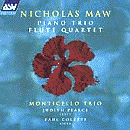 |
Piano Trio
Flute Quartet 2
 The Monticello Trio The Monticello Trio
Judith Pearce, flute2
Paul Coletti, viola 2
 ASV CD DCA 920 ASV CD DCA 920
Amazon
UK |
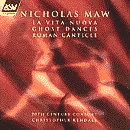 |
Ghost Dances
La Vita Nuova 2
Roman Canticle*
 Carmen Pelton,
soprano2 Carmen Pelton,
soprano2
William Sharp, baritone*
20th Century Consort/Christopher Kendall
 ASV CD DCA 999 ASV CD DCA 999
Amazon
UK
Amazon
US |
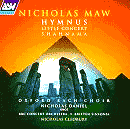 |
Hymnus 2
Little Concert*
Shahnama
 Nicholas Daniel, oboe* Nicholas Daniel, oboe*
Britten Sinfonia/Oxford Bach Choir2
BBC Concert Orchestra 2/Nicholas Cleobury
 ASV CD DCA 1070 ASV CD DCA 1070
Crotchet
Amazon
UK
Amazon
US |
|
Dance Scenes
 Philharmonia Orchestra - Daniel
Harding Philharmonia Orchestra - Daniel
Harding
 EMI 8 82648 2 (single
CD) [possibly deleted] EMI 8 82648 2 (single
CD) [possibly deleted] |
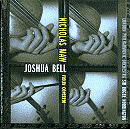 |
Concerto for Violin & Orchestra
 Joshua Bell, violin Joshua Bell, violin
London Philharmonic Orchestra/Sir Roger Norrington
 SONY SK 62856 SONY SK 62856
Crotchet
Amazon
UK
Amazon
US |
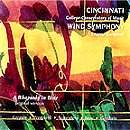 |
American Games
 Cincinnati College-Conservatory
of Music Wind Symphony/Eugene Corporon Cincinnati College-Conservatory
of Music Wind Symphony/Eugene Corporon
 KLAVIER KCD 11047 KLAVIER KCD 11047
Klavier |
In the LP era Nicholas Maw's music was reasonably well represented with among
others recordings of his masterpiece Scenes and Arias (1962, rev.
1966) and his masterly Life Studies (1973), the latter being later
reissued in CD format (CONTINUUM CCD 1030). Then there followed a long period
during which comparatively little was heard of him and his music although
he was then far from inactive. This roughly coincided with the many long
years devoted to the composition of Maw's magnum opus (Odyssey) which
occupied him for some 15 years and which was finally completed in 1987.
Some time after the premiere of the complete work, a recording of Odyssey
was released by EMI [CDS7542772
Crotchet
£25
Amazon
UK £27.99] and this superb recording and performance
seem to have somewhat rekindled interest in Maw's music which apparently
flowed more easily from his pen.
Recently a number of recordings of Maw's music have appeared. I have already
reviewed a NIMBUS CD featuring a new recording of Life Studies coupled
with the hitherto unrecorded beautiful Sonata Notturna (NIMBUS NI
5471 - BMS News 71 not available of this website).
So far ASV have released three CDs entirely devoted to Nicholas Maw's music
and one may hope that they will continue for there remain a number of works
unrecorded at the time of writing. A priority would be the three string quartets
(1965; 1982 and 1994) of which the first was recorded many years ago (LP
ARGO ZRG 565 - nla) and some recent and not-so-recent orchestral works as
well as some instrumental music such as Personae I-III (1973) and
Personae IV-VI (1985/6) both for piano and, incidentally, Maw's sole
works for piano to date. Another priority would be the Sonata for Solo Violin
(1996/7).
The three ASV releases under review provide for a very interesting and wide
ranging survey of Maw's compositional achievement over the last twenty years.
The earliest piece is the Flute Quartet (1981) and the most recent is
Hymnus for chorus and orchestra (1995/6). The Flute Quartet and the
somewhat later Piano Trio (1990/1) are among Maw's most classically elegant
works which might even be seen as neoclassical to some extent. Both pieces
get superbly polished performances by the Monticello Trio for whom the Piano
Trio was written and by Judith Pearce who is joined by the strings of the
Monticello Trio and the violist Paul Coletti.
La Vita Nuova (1979) has already been recorded by CHANDOS some years
ago. This beautiful work is probably one of Maw's finest achievements and,
in some ways, a smaller-scale sequel to the magnificent Scenes and
Arias. It is scored for soprano and chamber ensemble and sets Italian
love poems by medieval and Renaissance Italian authors. Maw's response to
the chosen texts is as varied and subtle as possible, with many beautiful
instrumental touches. In Maw's own way La Vita Nuova may undoubtedly
compare with Britten's better known cycles such as Serenade Op. 31
and Nocturne Op.60.
Ghost Dances completed in 1988 is subtitled Imaginary Ballet for
5 Players. It is written for the same instrumental forces as those for
Pierrot Lunaire, though without a voice part. Some "exotic" instruments
are also called for such as the manjeera [small finger cymbal], kazoo, flexatone,
strumstick [American one-stringed banjo or mandolin] and kalimba [African
thumb piano]. The composer explains that the ghost dances "are largely those
of memory, and the work may be thought of as a sequence of memory-related
and dream-distorted images of many different forms of the dance". This is
one of his most imaginative works and in it Maw creates an extraordinary
variety of moods by way of a subtle use of the instruments among which the
exotic ones help in the creation of an eerie expressionist climate. The piece
ends with the thin sounds of the kalimba "like a phantom piano played with
a bony finger" (Malcolm MacDonald). Maw at his most inventive. The beautifully
engraved study score of this superb piece is now available from FABER MUSIC
who also publish all the recent pieces by Maw.
Roman Canticle (1989, rev. 1991) is a setting for voice, flute, viola
and harp [the Debussy trio] of Robert Browning's 'Two in the Campagna'. "This
work revisits the Italian landscape through English eyes...[Maw's setting]
is for much of its length, impassioned and impetuous, agitated in its reverie,
an extended scherzo with a sombre ending" (Malcolm MacDonald). The Little
Concert (1987) - scored for oboe, two horns and strings - is a delightful
short piece "lighter in specific gravity and tone" (Nicholas Maw). It is
cast in form of an introduction and allegro, i.e. a long slow introduction
followed by an accompanied cadenza leading into a lively rondo. The emphasis
here is on song and quality of tone rather than on sheer instrumental virtuosity.
This fine short piece should become popular among oboists for it is well
worth more than the occasional hearing and could provide them with some
alternative to the more usual items in their repertoire. If Ghost Dances
is Maw's finest piece for small ensemble, then Shahnama (1992)
is his finest work for small orchestra. It draws its inspiration from the
eponymous 11th century Persian national epic which, we are told, during the
14th to the 16th centuries was copied with lavish illustrations. Nicholas
Maw says that "each little painting captures a dramatic moment...and [my
challenge] was to translate the visual experiences into an aural one". Each
tableau is separated by a chord heard in a variety of guises on the piano
which the composer likens to the turning of pages. This is a most colourful
work with many felicitous instrumental touches and yet another example of
Maw's assurance and mastery when writing for smaller forces.
By contrast Hymnus, composed in 1995/6 for the centenary of the Oxford
Bach Choir, is a substantial, ambitious work for chorus and orchestra. It
sets Saint Ambrose's Hymn at Dawn and the anonymous evening hymn Te
Lucis Ante Terminum. The first part of Hymnus begins deep in the
orchestra and with the first light of dawn, the chorus enters. The music
slowly builds towards some powerful climaxes interspersed with calmer, more
reflective episodes. The second part's opening contains some of the most
beautiful music ever penned by Maw: divided female voices provide a wordless
accompaniment to the men's chanting of the first words of the Evening Hymn.
The music again gains some momentum until the final restatement of the opening
thus bringing the work to its peaceful conclusion. Though written for amateur
choirs Hymnus is a quite demanding piece posing numerous problems
of intonation and articulation which, it must be said, are remarkably met
by the excellent Oxford Bach Choir. Again the results are well worth the
effort and the work should appeal to choral societies willing to add an
accessible contemporary work to their repertoire. The main drawback, though,
is the fairly large orchestra prescribed by Maw.
These three ASV CDs are most welcome and commendable because they provide
for an intriguing survey of Maw's recent output; the more so because the
performances are all very fine, the recorded sound superb and the insert
notes excellent.
Nicholas Maw's Violin Concerto completed in 1993 is another ambitious and
substantial piece. It is in four movements lasting some forty minutes. Here
is Maw at his most expansive and lyrical although, as a matter of contrast,
the Scherzo - incidentally the longest movement of the whole piece - is full
of energy. I must say that my first hearing of the concerto (a radio broadcast)
left me somewhat dissatisfied, and beautiful as this work is (and I firmly
believe it IS beautiful), it fails to satisfy me completely. I felt then
(and still do) that it is too long and that it might have been much more
convincing, had Maw decided to stop at the end of the third movement. The
fourth movement does not add much to the preceding ones though it concludes
the concerto with a lively display both from soloist and orchestra. Nevertheless
Maw's Violin Concerto is a remarkable achievement. It reasserts lyricism
and expression as the driving force in music at a time when so many composers
tend to negate its expressive power. Joshua Bell's glowing performance is
superbly supported by the London Philharmonic Orchestra conducted by Sir
Roger Norrington.
A few years after completing his Violin Concerto Maw wrote a big-scale Sonata
for Solo Violin (1996/7). This is in four movements and lasts a little under
half an hour. This may compare (and maybe compete) with Bartok's masterpiece
of 1944 written for Menuhin. The first movement Scena alternates two
very different tempi: Tempo I (Sostenuto) played on harmonics
and Tempo II (Moderato, ma con anima). The second movement
March-Burlesque acts as a fanciful scherzo and is followed
by the slow movement Tombeau marked Largo e tranquillo which
is played muted throughout and which is inscribed to the memory of a deceased
friend of the composer. The works ends with an animated finale Flight.
The score of this substantial piece is again published by FABER MUSIC and
it is to be hoped that it will soon be recorded.
The Dance Scenes of 1995 were commissioned by Rowe & Maw for their
centenary and written for the opening concert of the Philharmonia Orchestra's
50th anniversary season. This short colourful work is sophisticated light
music of the highest order. Its aim is to entertain and I think it succeeds
completely. It is a work to be enjoyed for the sheer brilliance of the
orchestration and its light-hearted exuberance. No major work maybe but one
of Maw's most endearing and attractive pieces.
American Games, a BBC commission for the 1991 Promenade Concerts,
is Maw's sole work, so far, for symphonic wind ensemble. It was first performed
in July 1991 by the RNCM Wind Band conducted by Timothy Reynish. In spite
of its title, there is very little in it that I recognise as specifically
American. The composer does however uses an original hymn tune which he describes
as his "version of a Baptist hymn" and introduces a "whiff of marching bands"
as well as some jazzy touches. The pieces falls into seven linked sections
framed by an introduction and a coda. It is a colourful, fairly straightforward
work lasting over twenty minutes which has since been recorded by the Cincinnati
College-Conservatory of Music Symphony conducted by Eugene Corporon (KLAVIER
KCD 11047, available from Maecenas Music, 5 Bushey Close, Old Barn Lane,
Kenley CR8 5AU). Incidentally this CD also includes a.o. Edward Gregson's
miniature concerto Celebrations (1990) as well as Schoenberg's Theme
and Variations Op. 43a (1943) and Vincent Persichetti's Symphony No.6
Op.69 (1956).
A final footnote. Night Thoughts (1982) for solo flute has
been recorded some years ago by Emily Beynon (METIER MSV CD 92006 BMS News
66).
Nicholas Maw's music is now being regularly recorded. All the releases under
review allow a good appreciation of his output over the last twenty years.
The remarkable artistic achievement of Scenes and Arias promised much
but - more importantly - gave ample proof that Maw's vision was deeply personal,
somewhat at odd with the prevailing trends. Scenes and Arias already
contained much of the lyricism which Maw would make his own over the years.
Indeed Nicholas Maw is presently working on his second opera Sophie's
Choice on a libretto by the composer after the novel of William Styron,
the premier of which is scheduled for September 2002 at the Royal Opera House,
Covent Garden conducted by Sir Simon Rattle.
"Maw has managed to ignore - and survive - all that is merely trendy, whether
technical or conceptual, in the difficult world of musical composition. Maw
has always remained true to his personal vision whether or not it was in
vogue at any given time". These words by Bruce Adolphe are, to my mind, the
most heartfelt tribute paid to an artist who has stuck to his ideals and
who, by so doing, earned the respect of his audiences and his performing
colleagues.
Hubert CULOT

